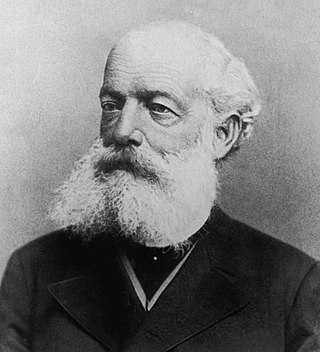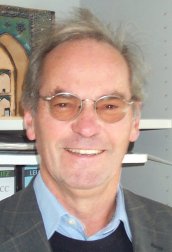
Friedrich August Kekulé, later Friedrich August Kekule von Stradonitz, was a German organic chemist. From the 1850s until his death, Kekulé was one of the most prominent chemists in Europe, especially in the field of theoretical chemistry. He was the principal founder of the theory of chemical structure and in particular the Kekulé structure of benzene.
Cheminformatics refers to the use of physical chemistry theory with computer and information science techniques—so called "in silico" techniques—in application to a range of descriptive and prescriptive problems in the field of chemistry, including in its applications to biology and related molecular fields. Such in silico techniques are used, for example, by pharmaceutical companies and in academic settings to aid and inform the process of drug discovery, for instance in the design of well-defined combinatorial libraries of synthetic compounds, or to assist in structure-based drug design. The methods can also be used in chemical and allied industries, and such fields as environmental science and pharmacology, where chemical processes are involved or studied.
Quantitative structure–activity relationship models are regression or classification models used in the chemical and biological sciences and engineering. Like other regression models, QSAR regression models relate a set of "predictor" variables (X) to the potency of the response variable (Y), while classification QSAR models relate the predictor variables to a categorical value of the response variable.

Richard Johann Kuhn was an Austrian-German biochemist who was awarded the Nobel Prize in Chemistry in 1938 "for his work on carotenoids and vitamins".

Tautomers are structural isomers of chemical compounds that readily interconvert. The chemical reaction interconverting the two is called tautomerization. This conversion commonly results from the relocation of a hydrogen atom within the compound. The phenomenon of tautomerization is called tautomerism, also called desmotropism. Tautomerism is for example relevant to the behavior of amino acids and nucleic acids, two of the fundamental building blocks of life.
Mathematical chemistry is the area of research engaged in novel applications of mathematics to chemistry; it concerns itself principally with the mathematical modeling of chemical phenomena. Mathematical chemistry has also sometimes been called computer chemistry, but should not be confused with computational chemistry.

Phorone, or diisopropylidene acetone, is a yellow crystalline substance with a geranium odor, with formula C9H14O or ( 2C=CH)2C=O.

Kyriacos Costa Nicolaou is a Cypriot-American chemist known for his research in the area of natural products total synthesis. He is currently Harry C. and Olga K. Wiess Professor of Chemistry at Rice University, having previously held academic positions at The Scripps Research Institute/UC San Diego and the University of Pennsylvania.

Levulinic acid, or 4-oxopentanoic acid, is an organic compound with the formula CH3C(O)CH2CH2CO2H. It is classified as a keto acid. This white crystalline solid is soluble in water and polar organic solvents. It is derived from degradation of cellulose and is a potential precursor to biofuels, such as ethyl levulinate.

ISIS/Draw was a chemical structure drawing program developed by MDL Information Systems. It introduced a number of file formats for the storage of chemical information that have become industry standards.

François Diederich was a Luxembourgian chemist specializing in organic chemistry.

Rolf Huisgen was a German chemist. His importance in synthetic organic chemistry extends to the enormous influence he had in post-war chemistry departments in Germany and Austria, due to a large number of his habilitants becoming professors. His major achievement was the development of the 1,3-dipolar cycloaddition reaction, also called the Huisgen cycloaddition.

Jure Zupan is a Slovenian physicist and founder of chemomectrics research in Slovenia, known for his work in applications and development of artificial neural networks in chemistry.
ChemWindow is a chemical structure drawing molecule editor and publishing program now published by John Wiley & Sons as of 2020, originally developed by Bio-Rad Laboratories, Inc. It was first developed by SoftShell International in the 1990s. Bio-Rad acquired this technology in 1996 and eventually made it part of their KnowItAll software product line, offering a specific ChemWindow edition of their software for structure drawing and publishing. They have also incorporated ChemWindow structure drawing components into their KnowItAll spectroscopy software packages with their DrawIt, ReportIt, and MineIt tools.

An alkylbenzene is a chemical compound that contains a monocyclic aromatic ring attaching to one or more saturated hydrocarbon chains. Alkylbenzenes are derivatives of benzene, in which one or more hydrogen atoms are replaced by alkyl groups. The simplest member, toluene, has the hydrogen atom of the benzene ring replaced by a methyl group. The chemical formula of alkylbenzenes is CnH2n-6.
Richard Dronskowski is a German chemist and physicist. He is a full professor at the RWTH Aachen University.

Ilan Marek is a bi-national French-Israeli chemist. He is particularly interested in the design and development of new stereo- and enantioselective strategies for the creation of several contiguous stereogenic centres and by the functionalization of organic molecules at the least reactive position. These processes are carried out in a single chemical step and lead to the synthesis of complex molecular structures. Understanding reaction mechanisms provides insight into the origins of stereoselectivity and governs optimization for the development of the most effective and general methodologies possible.

Klaus Müllen is a German chemist working in the fields of polymer chemistry, supramolecular chemistry and nanotechnology. He is known for the synthesis and exploration of the properties of graphene-like nanostructures and their potential applications in organic electronics.
Kristin Susan Bowman-James is an American chemist who is a distinguished professor at the University of Kansas. Her research makes use of host–guest chemistry to design new molecules for biology and the environment. She was awarded the 2021 American Chemical Society Award in Inorganic Chemistry.













